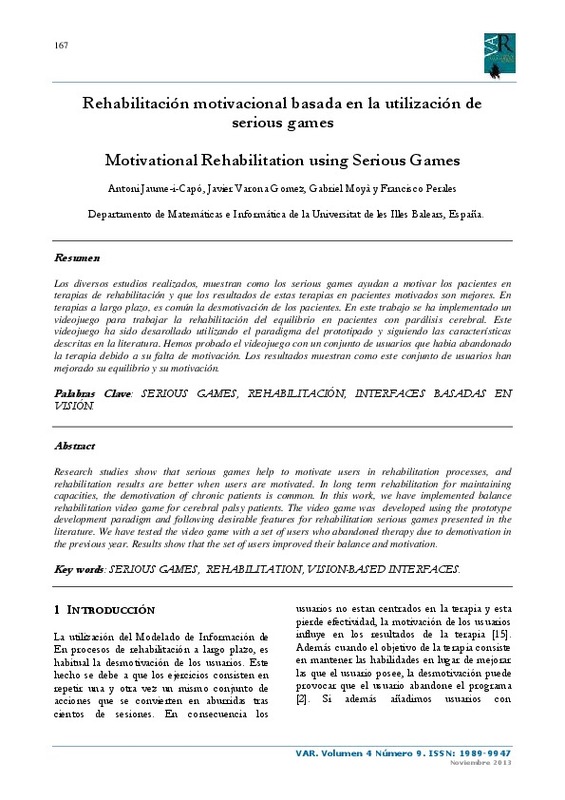BETKER, A. L., DESAI, A., NETT, C., KAPADIA, N., & SZTURM, T. (2007): Game-based exercises for dynamic short-sitting balance rehabilitation of people with chronic spinal cord and traumatic brain injuries. Physical Therapy. Retrieved from http://www.ptjournal.org/cgi/content/abstract/87/10/1389
BURKE, J. W., MCNEILL, M. D. J., CHARLES, D. K., MORROW, P. J., CROSBIE, J. H., & MCDONOUGH, S. M. (2009): Optimising engagement for stroke rehabilitation using serious games. Visual Computing, 25(12), 1085-1099. Springer. http://dx.doi.org/10.1007/s00371-009-0387-4
CAMEIRÃO, M. S., BERMÚDEZ I BADIA, S., DUARTE OLLER, E., & VERSCHURE, P. F. M. J. (2009): The rehabilitation gaming system: a review. Studies In Health Technology And Informatics, 145, 65-83. IOS Press. Retrieved from http://www.ncbi.nlm.nih.gov/pubmed/19592787
[+]
BETKER, A. L., DESAI, A., NETT, C., KAPADIA, N., & SZTURM, T. (2007): Game-based exercises for dynamic short-sitting balance rehabilitation of people with chronic spinal cord and traumatic brain injuries. Physical Therapy. Retrieved from http://www.ptjournal.org/cgi/content/abstract/87/10/1389
BURKE, J. W., MCNEILL, M. D. J., CHARLES, D. K., MORROW, P. J., CROSBIE, J. H., & MCDONOUGH, S. M. (2009): Optimising engagement for stroke rehabilitation using serious games. Visual Computing, 25(12), 1085-1099. Springer. http://dx.doi.org/10.1007/s00371-009-0387-4
CAMEIRÃO, M. S., BERMÚDEZ I BADIA, S., DUARTE OLLER, E., & VERSCHURE, P. F. M. J. (2009): The rehabilitation gaming system: a review. Studies In Health Technology And Informatics, 145, 65-83. IOS Press. Retrieved from http://www.ncbi.nlm.nih.gov/pubmed/19592787
FLORES, E., TOBON, G., CAVALLARO, E., CAVALLARO, F. I., PERRY, J. C., & KELLER, T. (2008): Improving patient motivation in game development for motor deficit
rehabilitation. Proceedings of the 2008 International Conference in Advances on Computer Entertainment Technology ACE 08, 7(8), 381. ACM Press. Retrieved from
http://portal.acm.org/citation.cfm?doid=1501750.1501839
FLYNN, S., PALMA, P., & BENDER, A. (2007): Feasibility of using the Sony PlayStation 2 gaming platform for an individual poststroke: a case report.Journal of neurologic physical therapy JNPT. Division of Physical Therapy, College of Health and Human Sciences, Georgia State University, Atlanta, Georgia, USA. sherylfl@usc.edu. Retrieved from http://www.ncbi.nlm.nih.gov/pubmed/18172415 http://dx.doi.org/10.1097/npt.0b013e31815d00d5
JUNG, Y. (2006): Tailoring Virtual Reality Technology for Stroke Rehabilitation : A Human Factors Design. Engineering, 929. ACM Press. Retrieved from
http://portal.acm.org/citation.cfm?doid=1125451.1125631
KRICHEVETS, A. N., SIROTKINA, E. B., YEVSEVICHEVA, I. V., & ZELDIN, L. M. (1995): Computer games as a means of movement rehabilitation. Disability and rehabilitation. Retrieved from http://www.ncbi.nlm.nih.gov/pubmed/7795259 http://dx.doi.org/10.3109/09638289509166635
MA, M., & BECHKOUM, K. (2008): Serious games for movement therapy after stroke. 2008 IEEE International Conference on Systems Man and Cybernetics, 1872-1877. IEEE. Retrieved from http://ieeexplore.ieee.org/lpdocs/epic03/wrapper.htm?arnumber=4811562 http://dx.doi.org/10.1109/icsmc.2008.4811562
MACLEAN, N., POUND, P., WOLFE, C., & RUDD, A. (2002): The concept of patient motivation: a qualitative analysis of stroke professionalsʼ attitudes. Stroke: A Journal of Cerebral Circulation, 33(2), 444-448. Retrieved from
http://stroke.ahajournals.org/cgi/doi/10.1161/hs0202.102367 http://dx.doi.org/10.1161/hs0202.102367
TINETTI, M. E., SPEECHLEY, M., & GINTER, S. F. (1988): Risk factors for falls among elderly persons living in the community. The New England Journal of Medicine,319(26), 1701-1707. Retrieved from http://www.ncbi.nlm.nih.gov/pubmed/3205267 http://dx.doi.org/10.1056/nejm198812293192604
[-]








